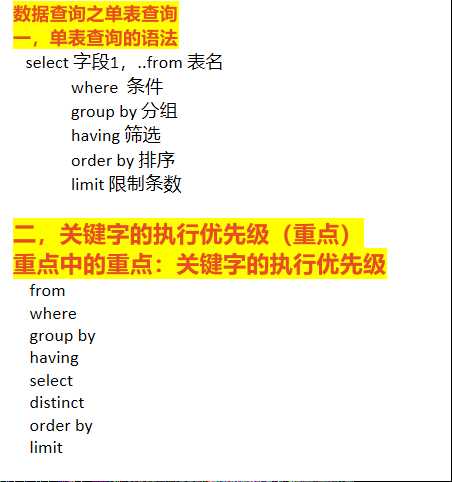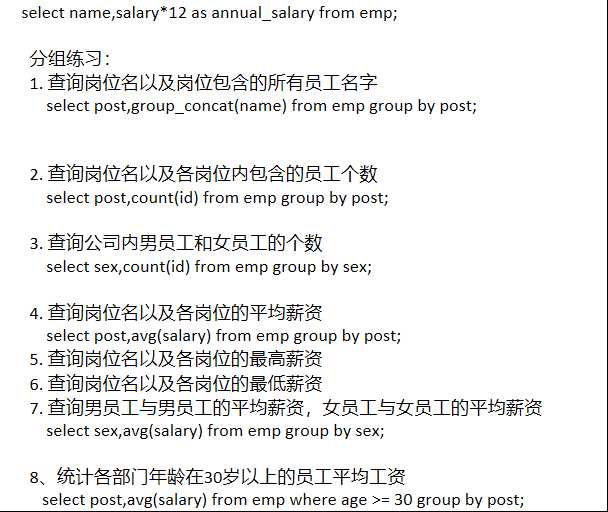数据库之单表查询
Posted maojiang
tags:
篇首语:本文由小常识网(cha138.com)小编为大家整理,主要介绍了数据库之单表查询相关的知识,希望对你有一定的参考价值。
select * from emp where name regexp ‘^jin.*(n|g)$‘;

找到表:from 2.拿着where指定的约束条件,去文件/表中取出一条条记录 3.将取出的一条条记录进行分组group by,如果没有group by,则整体作为一组 4.将分组的结果进行having过滤 5.执行select 6.去重 7.将结果按条件排序:order by 8.限制结果的显示条数 详细:http://www.cnblogs.com/linhaifeng/articles/7372774.html

准备表和记录 company.employee 员工id id int 姓名 emp_name varchar 性别 sex enum 年龄 age int 入职日期 hire_date date 岗位 post varchar 职位描述 post_comment varchar 薪水 salary double 办公室 office int 部门编号 depart_id int #创建表 create table emp( id int not null unique auto_increment, name varchar(20) not null, sex enum(‘male‘,‘female‘) not null default ‘male‘, #大部分是男的 age int(3) unsigned not null default 28, hire_date date not null, post varchar(50), post_comment varchar(100), salary double(15,2), office int, #一个部门一个屋子 depart_id int ); #查看表结构 mysql> desc employee; +--------------+-----------------------+------+-----+---------+----------------+ | Field | Type | Null | Key | Default | Extra | +--------------+-----------------------+------+-----+---------+----------------+ | id | int(11) | NO | PRI | NULL | auto_increment | | name | varchar(20) | NO | | NULL | | | sex | enum(‘male‘,‘female‘) | NO | | male | | | age | int(3) unsigned | NO | | 28 | | | hire_date | date | NO | | NULL | | | post | varchar(50) | YES | | NULL | | | post_comment | varchar(100) | YES | | NULL | | | salary | double(15,2) | YES | | NULL | | | office | int(11) | YES | | NULL | | | depart_id | int(11) | YES | | NULL | | +--------------+-----------------------+------+-----+---------+----------------+ #插入记录 #三个部门:教学,销售,运营 insert into emp(name,sex,age,hire_date,post,salary,office,depart_id) values (‘egon‘,‘male‘,18,‘20170301‘,‘老男孩驻沙河办事处外交大使‘,7300.33,401,1), #以下是教学部 (‘alex‘,‘male‘,78,‘20150302‘,‘teacher‘,1000000.31,401,1), (‘wupeiqi‘,‘male‘,81,‘20130305‘,‘teacher‘,8300,401,1), (‘yuanhao‘,‘male‘,73,‘20140701‘,‘teacher‘,3500,401,1), (‘liwenzhou‘,‘male‘,28,‘20121101‘,‘teacher‘,2100,401,1), (‘jingliyang‘,‘female‘,18,‘20110211‘,‘teacher‘,9000,401,1), (‘jinxin‘,‘male‘,18,‘19000301‘,‘teacher‘,30000,401,1), (‘成龙‘,‘male‘,48,‘20101111‘,‘teacher‘,10000,401,1), (‘歪歪‘,‘female‘,48,‘20150311‘,‘sale‘,3000.13,402,2),#以下是销售部门 (‘丫丫‘,‘female‘,38,‘20101101‘,‘sale‘,2000.35,402,2), (‘丁丁‘,‘female‘,18,‘20110312‘,‘sale‘,1000.37,402,2), (‘星星‘,‘female‘,18,‘20160513‘,‘sale‘,3000.29,402,2), (‘格格‘,‘female‘,28,‘20170127‘,‘sale‘,4000.33,402,2), (‘张野‘,‘male‘,28,‘20160311‘,‘operation‘,10000.13,403,3), #以下是运营部门 (‘程咬金‘,‘male‘,18,‘19970312‘,‘operation‘,20000,403,3), (‘程咬银‘,‘female‘,18,‘20130311‘,‘operation‘,19000,403,3), (‘程咬铜‘,‘male‘,18,‘20150411‘,‘operation‘,18000,403,3), (‘程咬铁‘,‘female‘,18,‘20140512‘,‘operation‘,17000,403,3) ; #ps:如果在windows系统中,插入中文字符,select的结果为空白,可以将所有字符编码统一设置成gbk


小练习: select id,name from db39.emp where id >= 3 and id <= 6; select * from db39.emp where id between 3 and 6; select * from emp where salary = 20000 or salary = 18000 or salary = 17000; select * from emp where salary in (20000,18000,17000); 要求:查询员工姓名中包含i字母的员工姓名与其薪资 select name,salary from db39.emp where name like ‘%i%‘ 要求:查询员工姓名是由四个字符组成的的员工姓名与其薪资 select name,salary from db39.emp where name like ‘____‘; select name,salary from db39.emp where char_length(name) = 4; select * from db39.emp where id not between 3 and 6; select * from emp where salary not in (20000,18000,17000); 要求:查询岗位描述为空的员工名与岗位名 select name,post from db39.emp where post_comment is NULL; select name,post from db39.emp where post_comment is not NULL;

一 什么是分组?为什么要分组? #1、首先明确一点:分组发生在where之后,即分组是基于where之后得到的记录而进行的 #2、分组指的是:将所有记录按照某个相同字段进行归类,比如针对员工信息表的职位分组,或者按照性别进行分组等 #3、为何要分组呢? 取每个部门的最高工资 取每个部门的员工数 取男人数和女人数 小窍门:‘每’这个字后面的字段,就是我们分组的依据 #4、大前提: 可以按照任意字段分组,但是分组完毕后,比如group by post,只能查看post字段,如果想查看组内信息,需要借助于聚合函数 二,only_full_group_by (聚合函数) 三,group by #设置sql_mode为only_full_group_by,意味着以后但凡分组,只能取到分组的依据默认 mysql> set global sql_mode="strict_trans_tables,only_full_group_by"; #每个部门的最高工资 select post,max(salary) from emp group by post; select post,min(salary) from emp group by post; select post,avg(salary) from emp group by post; select post,sum(salary) from emp group by post; select post,count(id) from emp group by post;

select post,group_concat(name) from emp group by post; select post,group_concat(name,"_SB") from emp group by post; select post,group_concat(name,": ",salary) from emp group by post; select post,group_concat(salary) from emp group by post;



select name as 姓名,salary as 薪资 from emp; mysql> select emp.id,emp.name from emp as t1; # 报错 mysql> select t1.id,t1.name from emp as t1;



having的语法格式与where一模一样,只不过having是在分组之后进行的进一步过滤 即where不能用聚合函数,而having是可以用聚合函数,这也是他们俩最大的区别 1、统计各部门年龄在30岁以上的员工平均工资,并且保留平均工资大于10000的部门 select post,avg(salary) from emp where age >= 30 group by post having avg(salary) > 10000; #强调:having必须在group by后面使用 select * from emp having avg(salary) > 10000;




select * from emp order by salary asc; #默认升序排 select * from emp order by salary desc; #降序排 select * from emp order by age desc; #降序排 select * from emp order by age desc,salary asc; #先按照age降序排,再按照薪资升序排 # 统计各部门年龄在10岁以上的员工平均工资,并且保留平均工资大于1000的部门, 然后对平均工资进行排序 select post,avg(salary) from emp where age > 10 group by post having avg(salary) > 1000 order by avg(salary) ;

select * from emp limit 3; select * from emp order by salary desc limit 1; # 分页显示 select * from emp limit 0,5; select * from emp limit 5,5;

select * from emp where name regexp ‘^jin.*(n|g)$‘;
以上是关于数据库之单表查询的主要内容,如果未能解决你的问题,请参考以下文章